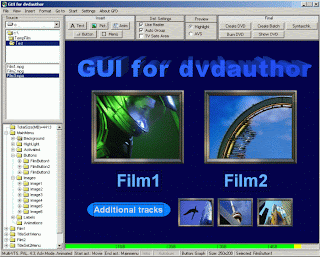
Overview: GFD was written primarily to get captured television broadcasts comfortably into a DVD conform format. Naturally you can use the program also for MPG videos of other origins, however no typical functions for copying DVDs (e.g. ripp, transcode...) are contained. To burn the final DVD use your favorite burning program, or simply that one, that was included with the DVD burner. GFD provides only the necessary VIDEO_TS and AUDIO_TS folders (as well as the VOB and IFO files). These can be burned with any DVD - burn program (UDF - ISO format). Problems with stand alone DVD players have occurred very rarely so far, however I can't give you a warranty. Since version 0.82 it is possible to burn also from GFD itself if Nero (version 5.5 or higher) is installed. Since version 0.99.2 also Imgburn is supported.
I tried to simplify the creation process for two typical cases as much as possible:
1. One titleset with homogeneous movies (concerning resolution, aspect...) as one has it e.g. with series. Here only one main menu with a selection of the films is provided, without own chapter menus (chapter marks may be used nevertheless).
2. Two (or more) titlesets with potentially different characteristics (concerning resolution, aspect...) per film. Here each film is put in its own titleset, where a chapter menu can be created (multi VTS DVD).
The program uses predominantly a drag & drop philosophy: Films (thus video streams), as well as chapters (in the titleset menus) are pulled on the menu background and can be positioned by drag with the left mouse button. With the right mouse button you may change some characteristics (font size, typeface, colors). Only the last added film can be deleted again = stack principle. The entire structure is shown in the "explorer view" window. As background picture for the menus the file default.jpg from the GFD directory is used by default. You may overwrite this file with any own JPG file.
The whole program is pixel-oriented, therefore the window has a fixed size of 1000 x 700 pixels. In the SOURCE window you can start a preview of the video with a double click, here you can also create screen shots to be used as pictures in the menus. The preview is based on the Windows Media Player, therefore all restrictions are accordingly. In particular the time indicator is not correct (specially for elementary streams). The program accepts elementary streams (these are multiplexed with mplex during the final creation of the DVD) or ready multiplexed streams, however the streams have to be multiplexed with mplex and the - f 8 option, otherwise they will not be accepted by dvdauthor.
Since version 0.99.2 it is possible to use MuxMan to create a DVD. MuxMan accepts elementary streams in DVD compliant resolution only. But it is faster in this case. If dvdauthor or MuxMan should be used has to be set up before any video is imported.
The program creates batch files for all single steps, these may be edited and then started "by hand" in a DOS window (Create batch) otherwise these batch files are started from GFD itself (Create DVD). The messages from dvdauthor, spumux... are shown in a log window and also saved to a log file. If you like to know more about the syntax of the XML instruction files, have a look to the dvdauthor manual and doku or the MuxMan documentation on the mpucoder page respectively.
Features and Limits
- PAL + NTSC
- 4:3 + 16:9
- SingleVTS + MultiVTS (with MultiVTS you may use different resolutions on a single DVD - without patch)
- Elementary + Multiplexed Video streams (mpv, m2v, m1v, mp2, ac3, dts, mpg, vob)
- Elementary Videostreams may be requantized (mpeg2 only!)
- 'Audio only' titles (for music DVDs form mp2 or ac3 audio files)
- Free definable fonts and colors (also for highlights)
- Movie preview
- Menu preview
- Chapter editor
- Chapter menus
- Animated menus (using Avisynth + DGMPGDec and HCenc or QuEnc)
- Audiomenus (advanced mode only)
- Subtitlemenus (advanced mode only)
- 'Switched' menus (advanced mode only)
- Transitions between menus (advanced + animated mode only)
- Intro
Limits:
- 50 Pictures per menu
- 50 Animations per menu
- 36 Buttons per menu
- 36 Free text labels per menu
- 98 Video titles (+ 1 Intro)
- 96 'Audio only' titles per audio titleset (one audio titleset replaces one video title)
- 50 Pages for Main menu (VTVM menu)
~ 1000 Menus in total (>180 not tested)
Multiplexed video streams must contain navigation packets
Fuente : http://download.videohelp.com/gfd/